
Introduction
Have you ever felt like your hair has a mind of its own, refusing to absorb moisturizers and leaving products just sitting on the surface? You might be dealing with low porosity hair. Understanding your hair’s porosity is the single most critical step toward unlocking a routine that actually works. It’s the difference between fighting a losing battle against dryness and product buildup, and achieving hair that is healthy, hydrated, and easy to manage.
This comprehensive guide is your ultimate resource for low porosity hair care. We will demystify the science behind it, show you how to confirm your hair type with a simple hair porosity test, and provide an actionable plan to moisturize, maintain, and grow your hair. Forget the frustration and get ready to build a personalized hair care plan that celebrates your unique texture.
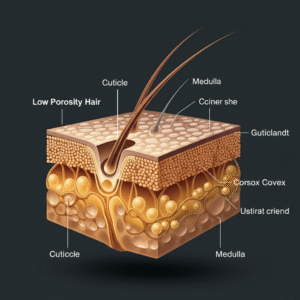
What is Low Porosity Hair?
To understand low porosity hair, you first need to understand the structure of a hair strand. Each strand has an outer layer called the hair cuticle, which is made up of tiny, overlapping scales, much like shingles on a roof. Porosity refers to how easily moisture and oils can pass through this cuticle layer to reach the inner cortex of the hair.
Low porosity hair has a tightly sealed cuticle layer. These “shingles” are packed down so closely that they create a barrier, making it difficult for water and conditioning ingredients to penetrate the hair shaft. While this sounds like a disadvantage, a tight cuticle is also a sign of a healthy, undamaged hair structure. The main challenge is getting the moisture in; once it’s there, low porosity hair is excellent at retaining it.
Key Characteristics of Low Porosity Hair:
- Moisture Resistance: Water tends to bead up on your hair rather than soaking in. It can take a long time for your hair to get fully saturated in the shower.
- Product Buildup: Products often seem to “sit” on top of your hair instead of being absorbed, leading to a greasy or coated feeling.
- Extended Drying Time: Because moisture struggles to get in, it also struggles to get out. Low porosity hair often takes hours, sometimes even a full day, to air dry completely.
- Shine: When healthy and properly moisturized, the flat, smooth cuticle of low porosity hair reflects light well, giving it a natural sheen.
If these traits sound familiar, you’re likely part of the low porosity club. The good news is that with the right techniques and products, you can work with your hair’s natural structure, not against it.
How to Test for Low Porosity Hair
While the characteristics above are strong indicators, a definitive hair porosity test can confirm your hair type. These simple DIY hair tests will give you a clear answer, removing the guesswork from your hair care journey. For the most accurate results, make sure to perform these tests on clean, dry hair that is free of any product.
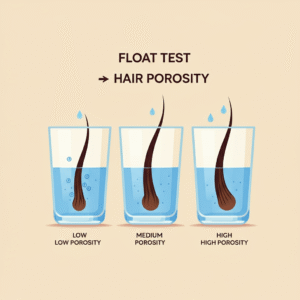
The Float Test (Water Test for Hair Porosity)
This is the most popular and straightforward method for determining hair porosity.
- Get a Clean Strand: After washing and drying your hair, take a single strand that has shed naturally. You can find one on your brush or comb.
- Prepare the Water: Fill a clear glass or bowl with room-temperature water.
- Place the Hair in Water: Gently drop the hair strand onto the surface of the water.
- Observe: Watch the strand for 2-4 minutes.
-
- Floats at the top: If your hair remains floating at the surface, you have low porosity hair. The tightly bound cuticle is repelling the water.
- Sinks slowly or floats in the middle: If the strand hovers in the middle of the glass, you have medium or normal porosity hair.
- Sinks quickly to the bottom: If your hair plummets to the bottom almost immediately, you have high porosity hair.
The Spray Bottle Test
Another easy DIY hair test is the spray bottle method.
- Take a small, clean section of your dry hair.
- Mist it with water from a spray bottle.
- Observe what the water does. If you see tiny beads of water sitting on the surface of your strands, it’s a clear sign of low porosity. High porosity hair, in contrast, would absorb the water almost instantly.
Once you’ve confirmed you have low porosity hair, you can start to understand the specific challenges it faces and, more importantly, how to solve them.
Common Problems with Low Porosity Hair
The unique structure of low porosity hair leads to a specific set of challenges. Recognizing these issues is the first step toward building an effective low porosity hair routine that promotes moisture and growth.
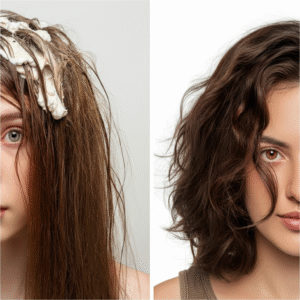
1. Persistent Dryness
It might seem contradictory, but hair that resists water can be chronically dry. Because the hair cuticle is so compact, moisturizers have a hard time getting in. You can apply creams, leave-ins, and oils, but if they aren’t formulated correctly or applied with the right technique, they’ll just coat the hair’s exterior, leaving the inner cortex thirsty. This leads to hair that feels brittle and straw-like, even after a wash day full of moisturizing products.
2. Product Buildup
This is the number one complaint from those with low porosity hair. Heavy butters, thick creams, and certain oils are too large to penetrate the tight cuticle. Instead, they create a film on the hair shaft. This product buildup can weigh your hair down, make it look dull and greasy, and even clog your scalp’s pores. Worse, this layer of buildup makes it even harder for any subsequent products to get through, creating a vicious cycle of dryness and greasiness.
3. Protein Sensitivity and Protein Overload
Protein treatments are often praised for strengthening hair. However, low porosity hair is naturally strong due to its compact cuticle structure. It generally doesn’t need as much supplemental protein. When you use too many protein-rich products, the protein molecules deposit onto the already-fortified hair shaft, causing it to become rigid, stiff, and extremely brittle. This state, known as protein overload, can lead to significant breakage. Your hair might feel rough and lose its natural elasticity.
4. Difficulty with Chemical Processes
The moisture-resistant nature of low porosity hair also makes it resistant to chemical treatments. It can be more challenging to color, as the dye has a harder time penetrating the hair cuticle to deposit pigment. This can result in less vibrant color or color that fades more quickly. Similarly, chemical relaxers or perms may require longer processing times to be effective.
Understanding these common problems helps you target your care routine effectively. The goal is to get moisture in, seal it without causing buildup, and maintain a healthy protein-moisture balance.
The Ultimate Low Porosity Hair Care Routine
Crafting the perfect low porosity hair care plan is about strategy and consistency. This daily and weekly routine focuses on getting moisture to penetrate the hair shaft and keeping it there, all while avoiding the dreaded product buildup.
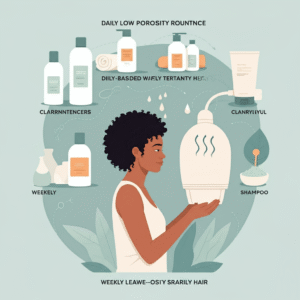
Daily Hair Care Routine
Simplicity is key for daily care. The goal is to maintain moisture without weighing your hair down.
- Refresh with Water or Steam: Your hair loves water. Start your day by lightly misting your hair with water or a water-based leave-in spray. Even better, let the steam from your shower provide some gentle hydration. Steam is a form of water vapor with smaller molecules that can more easily enter the hair cuticle.
- Use Lightweight Products: Avoid heavy butters and creams for daily styling. Opt for water-based lotions, milks, or foams. These products provide moisture without creating a heavy film.
- Detangle When Damp: Low porosity hair is strongest when wet. Detangle gently using your fingers or a wide-tooth comb while your hair is damp and saturated with a slippery leave-in conditioner. This minimizes friction and prevents breakage.
- Focus on the Ends: The ends of your hair are the oldest and most fragile. Pay extra attention to them, applying a small amount of a lightweight oil to seal in the moisture from your leave-in conditioner.
Weekly Hair Care Routine
Your weekly wash day is the foundation of a successful low porosity hair care regimen. This is your main opportunity to deeply cleanse and moisturize your hair.
Step 1: Pre-Poo (Optional but Recommended)
Before shampooing, apply a lightweight oil like grapeseed, sweet almond, or jojoba oil to your dry hair. Let it sit for 15-20 minutes, perhaps under a plastic cap to trap heat. This step protects your hair from being completely stripped by the shampoo and makes detangling easier.
Step 2: Cleanse with a Clarifying Shampoo
Because low porosity hair is so prone to buildup, regular clarification is non-negotiable. Once or twice a month, use a sulfate-free clarifying shampoo to remove all traces of old product, hard water minerals, and environmental pollutants. This “resets” your hair, allowing it to better receive moisture. For your other weekly washes, a gentle, moisturizing, sulfate-free shampoo will suffice. When shampooing, focus the product on your scalp where most buildup occurs.
Step 3: Deep Condition with Heat
This is the most crucial step in any low porosity hair routine. Heat gently lifts the hair cuticle, creating a pathway for your deep conditioner to penetrate deeply. Without heat, your conditioner will likely just sit on the surface.
- Application: Apply a generous amount of a protein-free, moisturizing deep conditioner to your clean, wet hair.
- Applying Heat:
-
- Steam Treatment: Use a tabletop steamer or a handheld steamer to infuse your hair with moist heat. This is the most effective method.
- Heat Cap: Cover your hair with a plastic cap and sit under a hooded dryer or use a thermal heat cap for 20-30 minutes.
- Warm Towel: If you don’t have special tools, cover your hair with a plastic cap, then wrap a warm, damp towel around your head. You may need to refresh the towel’s heat.
- Rinsing: After the treatment, rinse your hair with cool water. This helps to close the cuticle and lock in the moisture you just worked so hard to get in.
Step 4: Moisturize and Seal (LOC/LCO Method)
After deep conditioning, it’s time to layer your products to lock in hydration. The LOC (Liquid, Oil, Cream) or LCO (Liquid, Cream, Oil) method works well. For low porosity hair, always prioritize lightweight products.
- Liquid (L): Apply a water-based leave-in conditioner to your dripping wet hair. This is your primary moisture layer.
- Cream (C): Follow up with a lightweight, water-based curling cream or hair milk to help define your style and add another layer of hydration.
- Oil (O): Finish with a few drops of a lightweight oil to seal everything in. Argan, grapeseed, and jojoba oils are excellent choices. This final layer acts as a barrier to prevent moisture from escaping.
By following this routine, you address all the major needs of low porosity hair: removing buildup, infusing deep moisture with heat, and sealing it in with light layers.
Best Ingredients & Products for Low Porosity Hair
Choosing the right products is a game-changer. For low porosity hair, the ingredient list is more important than the brand name. You’re looking for humectants that attract moisture and lightweight formulas that won’t cause buildup.
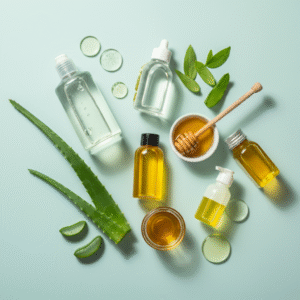
Hydrating Ingredients to Look For:
These ingredients are humectants, meaning they draw moisture from the air into your hair. They are water-soluble and easily penetrate the hair shaft.
- Glycerin: A powerful humectant that provides excellent slip and hydration. Look for it high up on the ingredient list in conditioners and leave-ins.
- Aloe Vera: This plant-based ingredient is mostly water and is packed with vitamins and minerals. It’s incredibly hydrating and soothing for the scalp.
- Honey & Agave Nectar: Natural humectants that not only attract moisture but also add a beautiful shine to the hair.
- Panthenol (Pro-Vitamin B5): Penetrates the hair shaft to provide long-lasting moisture and improves elasticity.
- Sodium Hyaluronate (Hyaluronic Acid): Known for holding 1,000 times its weight in water, it’s a super-hydrator for hair, just as it is for skin.
Lightweight Oils for Sealing:
Not all oils are created equal. Low porosity hair needs oils that are light enough to not just sit on the surface. These oils help seal in moisture without weighing your hair down.
- Grapeseed Oil: Extremely lightweight and non-greasy, it’s perfect for sealing and adding shine.
- Argan Oil: Rich in fatty acids and vitamin E, it absorbs quickly and helps to reduce frizz.
- Jojoba Oil: This oil’s molecular structure is very similar to the natural sebum produced by your scalp, making it an excellent moisturizer and sealant.
- Sweet Almond Oil: A great all-around oil that provides moisture and shine without being too heavy.
Ingredients and Products to Avoid:
- Heavy Butters and Oils: Shea butter, castor oil, and olive oil are often too heavy and can easily cause buildup. While some people can use them sparingly on their ends, they should generally be avoided in daily stylers. Coconut oil can also be problematic for some, as it can build up and act like a protein, causing stiffness.
- Protein-Heavy Products: Regularly check your product labels for ingredients like “hydrolyzed wheat protein,” “keratin,” “collagen,” or “silk amino acids.” Use these products sparingly, if at all.
- Silicones: Ingredients ending in “-cone” (like dimethicone) can create a waterproof film on the hair, leading to severe buildup and preventing moisture from getting in.
Recommended Product Types:
When shopping for the best products for low porosity hair, look for these categories:
- Clarifying Shampoo: A must-have for monthly use to combat buildup.
- Moisturizing, Sulfate-Free Shampoo: For regular weekly cleansing.
- Protein-Free Deep Conditioner: Your go-to for weekly deep conditioning treatments.
- Water-Based Leave-In Conditioner: The foundation of your daily moisture routine.
- Lightweight Creams and Lotions: For styling and defining curls or waves without the weight.
By becoming an expert label-reader, you can confidently select products that will hydrate and nourish your low porosity hair.
Protein Treatments & Low Porosity Hair
The relationship between low porosity hair and protein is delicate. While protein is essential for hair health, this hair type is prone to protein overload, a condition that makes hair feel stiff, brittle, and dry. Understanding how to manage protein is a key part of advanced low porosity hair care.
Why is Low Porosity Hair Sensitive to Protein?
The cuticle of low porosity hair is already strong and compact. Protein treatments work by filling in gaps in the cuticle to strengthen it. Since low porosity hair has very few gaps to begin with, the protein molecules simply coat the outside of the hair shaft. This extra layer reinforces an already rigid structure, leading to a loss of elasticity. When hair can’t bend and stretch, it snaps.
Signs of Protein Overload:
If you’re experiencing any of the following, you may have too much protein in your routine:
- Hair feels unusually stiff, rough, or straw-like.
- A sudden increase in shedding and breakage.
- Your curls or waves lose their definition and become limp or straight.
- Hair looks dull and lacks shine, even when moisturized.
Finding the Right Protein-Moisture Balance
Most people with low porosity hair don’t need regular, intensive protein treatments. Instead, the goal is to incorporate small amounts of protein only when necessary.
When to Consider a Protein Treatment:
- After a Chemical Service: If you’ve recently colored or relaxed your hair, a mild protein treatment can help reinforce the bonds that may have been weakened.
- If Your Hair Feels “Mushy”: If your hair feels overly soft, limp, and has too much elasticity (a sign of over-moisturizing or “hygral fatigue”), a light protein treatment can help restore its structure.
How to Use Protein Safely:
- Opt for Lighter Proteins: Instead of heavy keratin treatments, look for products with amino acids or lighter hydrolyzed proteins.
- Use It Infrequently: A light protein treatment once every 4-6 weeks is usually more than enough. Some may only need it a few times a year.
- Follow Up with Moisture: Always follow a protein treatment with a moisturizing, protein-free deep conditioner. This restores the flexibility and softness to your hair, preventing it from becoming brittle. This is a crucial step in your low porosity hair treatment plan.
Listen to your hair. Its texture and behavior will tell you what it needs. If it starts to feel stiff, cut back on all products containing protein. If it feels overly soft and weak, consider a very mild treatment.
Protective Hairstyles for Low Porosity Hair
Protective styling is a fantastic way to support hair growth for low porosity hair. These styles minimize daily manipulation, protect your delicate ends from friction and breakage, and help with moisture retention.
The key to successful protective styling for low porosity hair is to ensure your hair is thoroughly moisturized before styling.
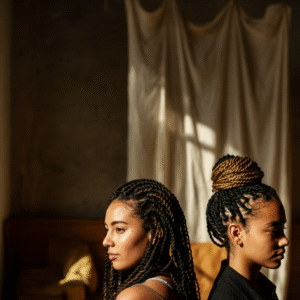
Best Protective Styles:
- Twists or Braids: Two-strand twists, three-strand braids (plaits), and flat twists are excellent options. They keep the hair stretched and contained, reducing tangles and single-strand knots. They can be worn as is or used to create a “twist-out” or “braid-out” for a defined style later.
- Buns and Updos: A simple high bun (the “pineapple”), a low bun, or elegant updos keep your ends tucked away and protected. Be sure not to pull too tightly on your edges to avoid traction alopecia.
- Bantu Knots: This style involves twisting sections of hair and wrapping them into small knots. It’s great for stretching the hair and creating beautiful, heatless curls when taken down.
Night Care is Non-Negotiable
How you protect your hair at night is just as important as how you style it during the day. Cotton pillowcases are highly absorbent and will suck the moisture right out of your hair, while the friction can cause frizz and breakage.
- Silk or Satin Pillowcase: The single best investment you can make for your hair’s health. The smooth surface reduces friction, helping to preserve your style and retain moisture.
- Satin Bonnet or Scarf: For extra protection, especially if you have longer hair or a more intricate style, wearing a satin bonnet or wrapping your hair in a satin scarf is ideal. This creates a secure barrier against moisture loss.
- The “Pineapple” Method: For those with curly or coily hair, loosely gathering your hair at the very top of your head in a high, loose ponytail (using a satin scrunchie) can help preserve your curl pattern overnight.
By combining proper moisturizing techniques with low-manipulation styles and diligent night care, you create the perfect environment for your low porosity hair to thrive and grow long.
Common Mistakes to Avoid
Even with the best intentions, a few common missteps can sabotage your low porosity hair care efforts. Avoiding these pitfalls will help you get the best results from your routine.
- Using Heavy, Butter-Based Products: This is the most frequent mistake. It’s easy to assume that thick, rich products will combat dryness, but for low porosity hair, they do the opposite. They coat the hair, block moisture, and cause heavy buildup. Stick to water-based and lightweight formulas.
- Skipping Heat During Deep Conditioning: Applying a deep conditioner without heat is like sending a letter without a stamp—it won’t reach its destination. Heat is essential for lifting the hair cuticle to allow the conditioner to penetrate. A steam treatment or heat cap isn’t a luxury; it’s a necessity for an effective low porosity hair treatment.
- Applying Products to Dry Hair: Low porosity hair best absorbs products when it is wet. Applying stylers or moisturizers to dry hair almost guarantees they will just sit on the surface. Always apply your leave-in conditioners and creams to damp or soaking wet hair to trap the water molecules inside the strand.
- Overusing Protein: As discussed, this hair type is sensitive to protein. Using a weekly “reconstructing” mask or having protein in every product in your lineup (shampoo, conditioner, leave-in) will quickly lead to protein overload, resulting in stiff, brittle hair that breaks easily.
- Neglecting to Clarify: Avoiding sulfates is good advice, but never clarifying is a mistake. Product buildup is inevitable. A monthly wash with a clarifying shampoo is crucial to “deep clean” your strands and scalp, creating a clean slate for your products to work effectively.
By steering clear of these common errors, you’ll be well on your way to mastering your hair’s unique needs.
Lifestyle Tips for Healthier Low Porosity Hair
Healthy hair starts from within. While products and techniques are vital, your overall lifestyle plays a significant role in the health and growth of your hair. These tips complement your external low porosity hair care routine.
1. Hydrate from the Inside Out
Your hair is a part of your body. If you are dehydrated, your body will prioritize vital organs, leaving little moisture for your hair, skin, and nails. Drinking an adequate amount of water throughout the day helps to hydrate your body at a cellular level, which supports a healthy scalp and can improve the condition of the hair that grows from it.
2. Eat a Balanced Diet for Hair Growth
Your hair follicles need a steady supply of nutrients to produce strong, healthy hair. Focus on a diet rich in:
- Biotin: Found in eggs, almonds, and sweet potatoes.
- Iron: Crucial for preventing hair shedding. Found in spinach, lentils, and red meat.
- Protein: The building block of hair. Lean meats, fish, beans, and nuts are great sources.
- Vitamin C: Helps with iron absorption and collagen production. Found in citrus fruits, bell peppers, and strawberries.
- Zinc: A deficiency can lead to hair loss. Found in pumpkin seeds, chickpeas, and beef.
3. Stimulate Your Scalp
A healthy scalp is the foundation for hair growth for low porosity hair. Regular scalp massages can help increase blood circulation to the hair follicles, delivering more oxygen and nutrients to where they are needed most. You can perform a scalp massage with your fingertips for a few minutes each day or use a few drops of a lightweight oil like jojoba or grapeseed oil during your pre-poo routine.
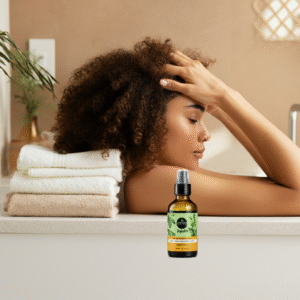
4. Minimize Heat Styling
While using indirect heat for deep conditioning is beneficial, direct heat from flat irons, curling wands, and high-heat blow dryers can be damaging. It can cause moisture to rapidly leave the hair shaft, leading to dryness and breakage. If you must use direct heat, always apply a heat protectant first and use the lowest effective temperature setting.
Conclusion: Your Journey to Healthy Hair
Mastering low porosity hair care is a journey of understanding and consistency. It’s not about fighting your hair’s natural tendencies, but learning to work with them. The core principles are simple: use lightweight, water-based products; leverage heat to get moisture in; clarify regularly to prevent buildup; and be mindful of protein.
By using the hair porosity test to confirm your hair type and implementing the routines and tips in this guide, you can finally say goodbye to chronic dryness and frustration. Embrace your hair’s unique structure, build a personalized routine that addresses its needs, and get ready to enjoy the strong, shiny, and beautifully hydrated hair you deserve.
FAQs About Low Porosity Hair
Here are answers to some of the most frequently asked questions about managing low porosity hair.
Q: How often should I deep condition low porosity hair?
A: You should aim to deep condition with heat once a week. Consistency is the key to keeping low porosity hair properly moisturized. This weekly deep conditioning session is the cornerstone of a healthy routine.
Q: What are the absolute best oils for sealing moisture?
A: The best oils are lightweight and absorb easily. Top choices include grapeseed oil, argan oil, jojoba oil, and sweet almond oil. Avoid heavy oils like castor oil, olive oil, and shea butter for sealing, as they are more likely to cause buildup.
Q: Can low porosity hair grow long?
A: Absolutely! The compact cuticle of low porosity hair makes it naturally strong and less prone to breakage than high porosity hair. The primary barrier to length retention is dryness-induced breakage. By mastering a routine that focuses on moisture retention and gentle handling, you can achieve significant hair growth for low porosity hair.
Q: Is it necessary to use a clarifying shampoo?
A: Yes, it is highly recommended. Because products and even minerals from hard water can easily build up on the surface of low porosity hair, using a clarifying shampoo once or twice a month is essential to remove this buildup and allow your moisturizing products to work effectively.
Q: My hair feels dry even after using water-based products. What am I doing wrong?
A: The most likely culprit is your application technique. Ensure you are applying products to wet, not just damp, hair. And most importantly, are you using heat with your weekly deep conditioner? Without heat, even the best products will struggle to penetrate the hair shaft. A steam treatment can make a world of difference.





Leave a Reply